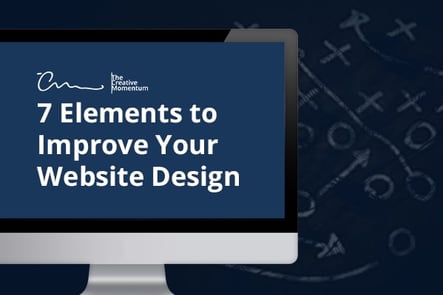
A fatal flaw of many site owners is that they think they know why their page is underperforming. Unfortunately, this is rarely the case. There are lots of variables that affect how users respond to your site, from the domain you’ve chosen to the layout of the page to the tiniest minutiae that influence visitor emotions.
First, assess your site as a whole
You can’t approach website improvement in a granular way—the entire thing needs to be assessed as a unit. This is due in part to the psychological blunders we humans make when searching for things to improve. If we scrutinize our ad copy long enough, we’ll probably start second-guessing it.
To counter this, work with a professional who has experience looking at the big picture and identifying weak spots. It’s easy to lose the forest for the trees when you’re close to a project—get some outside help to guide you along.
Don't make your navigation too cute
We harp on this quite a bit at The Creative Momentum, but it's out of love, truly. A site's navigation is the skeletal structure by which visitors get to where they want to go. When a site is difficult to traverse, frustration sets in. Frustration leads to hate. Hate leads to suffering. Suffering leads to the dark si— oh, sorry, it leads to irate cursing as people move on to your competition instead.
Does your site reflect your brand?
A great looking website is awesome, but the point of your web page isn’t to be sexy—it’s to deliver results. With that in mind, consider how well your page reflects your brand identity and supports your marketing goals.
Do your stylistic choices reflect the tone and culture of your brand? Does your page copy speak in terms your target market will appreciate? Your brand must be consistent in its messaging, from the website you build to the content you promote.
Speaking of consistency, does everything make sense as a greater whole?
Consistency might seem like a nebulous concept, but it’s not just lip service. Your website is a tool that should guide users through your philosophy as a company and prime them for conversion—which only happens when viewers understand what you’re all about. Lucidpress surveyed over 200 marketing executives and brand leaders to find that 90 percent of respondents believed there was noticeable inconsistency in the brand materials they created, but over half (55 percent) felt that brand consistency was a significant driver of growth.
Is it easy to buy from you?
We can't tell you how many times we've seen great-looking sites that catch our imaginations, only to find there's no end goal. If you're selling something, you need to make sure it's easy to buy from you. Obscure and cute shopping carts, difficult to find product "buy" buttons, or a lack of clear calls-to-action lead to one thing; hot leads moving on to another site.
Never stop testing
Nothing on your site should be there by accident. Everything has a purpose, whether it’s a bit of ad copy designed to get users thinking about a concept or the use of cool color tones to put users in a relaxed mood. With that in mind, improving website design often means digging into details to determine what elements are failing to live up to their intended purpose.
Optimize your site, both on-page and off
For marketing success, a site needs to be optimized—but this can only happen if you've tested what works and what doesn't. Once you have the right idea for what will get your site to rank highly with your target market, continue to work on your site's content, speed, and web presence. SEO isn't a one-time operation, it's a never-ending maintenance process that requires patience to truly work.
Improving Website Design
There are countless ways you can improve your website design, but the above framework will set you on the right path:
- Start with a broad assessment of your website and narrow your focus as you identify under-performing elements
- Ensure all on-site elements reflect the spirit of your brand and are consistent in their messaging
- Continually monitor the performance of your on-page elements to fine-tune your site without wrecking the elements that are working fine
And above all, don’t assume—it’s hard to know what to improve when you’re close to a project. Keep an open mind and trust in the professionals you’ve chosen to guide you.


